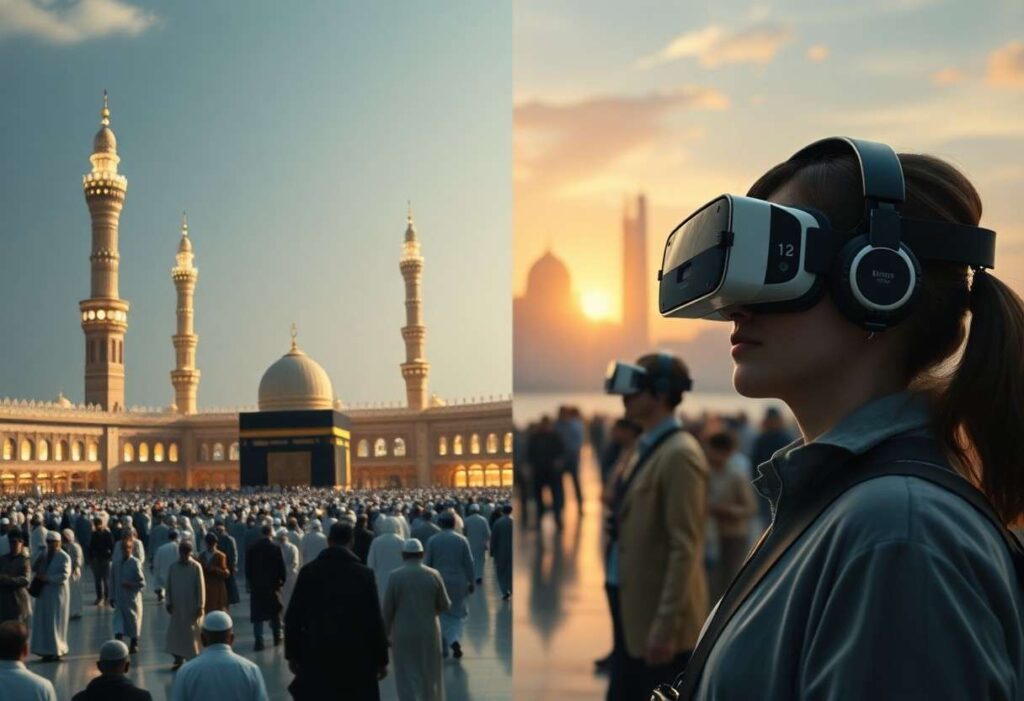Most people today grapple with the challenge of maintaining their spiritual practices in an increasingly digital world. As you navigate the ever-evolving landscape of technology, it’s imperative to reflect on how these changes impact your faith. This blog post will explore the intersection of spirituality and the digital realm, examining whether your beliefs can thrive amidst the myriad distractions that come with the Metaverse. Join us as we research into the implications of these digital environments on your soul and religious devotion.
The Evolution of Faith in the Digital Age
The evolution of faith in the digital age reflects the transformative impact of technology on religious practices. Today, people are finding new ways to connect with their spirituality through online platforms, social media, and virtual communities. This shift not only offers unprecedented access to religious resources but also reshapes traditional concepts of worship and fellowship, allowing for greater inclusivity and diverse expressions of faith.
Historical Context of Religious Practices
Any understanding of modern faith practices requires a look back at how religious beliefs and rituals have evolved over centuries. Historically, faith has been a communal experience, often tied to specific locations and physical gatherings. As societies advanced, reaching beyond local boundaries, the ways you practiced your beliefs began to change, influenced by cultural exchanges, technology, and social movements.
The Rise of Digital Faith Communities
For many, the rise of digital faith communities represents a significant shift in how spiritual connections are formed and maintained. These online platforms empower you to engage with others who share your beliefs, regardless of geographical limitations. With social media, webinars, and online worship services, you can connect, share, and grow in your faith wherever you are.
Rise of digital faith communities illustrates the adaptability of spirituality in an ever-evolving landscape. They provide a space for dialogue, support, and communal worship, allowing you to participate in real-time discussions, attend virtual services, and join worldwide prayer groups. This newfound accessibility empowers individuals to explore diverse religious expressions and fosters a sense of belonging that transcends traditional barriers, challenging the notion that faith must be practiced within the confines of physical spaces.
Understanding Distractions in a Digital World
Even in an era where you can connect with the world at your fingertips, distractions abound. The digital landscape inundates you with information, notifications, and content that can easily lead to a fragmented focus. This constant pull on your attention not only affects productivity but can also impede your spiritual practices, leaving you grappling with the challenge of maintaining meaningful connections with your faith amidst an overwhelming sea of digital noise.
The Impact of Technology on Attention
Beside enhancing your access to information, technology can diminish your ability to concentrate. The ever-present notifications and the lure of multitasking can scatter your attention. You may find it increasingly difficult to engage deeply with your thoughts or your beliefs, as the rapid pace of digital interactions often reduces your capacity for sustained reflection, which is vital for spiritual growth.
Social Media and Spiritual Engagement
On one hand, social media can serve as a platform for fostering spiritual community, but on the other, it can dilute your focus. These platforms might make it easier for you to share faith-related content and connect with others who share your beliefs, yet the constant distractions can prevent you from engaging deeply in those interactions. You might find that scrolling through posts leaves little room for meaningful reflection or spiritual growth.
World events, inspirational quotes, and communal prayers flood your social media feeds, offering a sense of belonging. However, the rapid consumption of content may lead you to skim over rich discussions or uplifting messages that require deeper engagement. As you navigate this landscape, it’s important to find balance. Consider setting aside dedicated time for spiritual reflection that isn’t interrupted by digital distractions, allowing you to strengthen your faith amidst the chaos of the online world.
The Metaverse: A New Frontier for Faith
Clearly, the Metaverse presents a groundbreaking opportunity for faith communities to evolve and reach new audiences. This expansive digital realm allows for innovative ways of worship, community building, and spiritual engagement that weren’t previously possible. As you navigate this virtual landscape, your faith experience can transcend geographic and social barriers, offering a rich tapestry of interactions, teachings, and connections in ways that reflect a modern societal landscape.
Virtual Worship and Its Benefits
Across the Metaverse, virtual worship offers numerous benefits that can enhance your spiritual life. You can join services from the comfort of your home, engage with diverse faith communities, and access resources tailored to your beliefs. This digitized form of worship allows for flexibility in scheduling and participation, encouraging a more inclusive atmosphere for individuals who might have felt alienated in traditional settings.
Challenges and Limitations of Digital Worship
Metaverse worship does come with its own set of challenges and limitations that you should consider. While digital interactions may enhance accessibility, they often lack the depth of personal connection found in physical gatherings. Distractions abound in the online environment, potentially hindering your focus during spiritual practices. Additionally, the experience may not resonate for everyone, with varying comfort levels around technology affecting engagement.
But you should be aware that the limitations of digital worship can pose significant hurdles. For instance, the absence of physical congregation can impede the development of deep, meaningful relationships that often blossom through in-person interactions. Moreover, not everyone is tech-savvy, which can lead to exclusion for those unfamiliar with navigating virtual platforms. Furthermore, digital worship environments can sometimes prioritize entertainment over spirituality, which could detract from the core essence of faith that you seek. A thoughtful approach is crucial to address these challenges as you embrace this new frontier for faith.
Case Studies: Faith in the Age of Technology
All around the world, faith communities are navigating the intersection of spirituality and technology. Here are notable case studies demonstrating how religious institutions are adapting and thriving in the digital age:
- 1. Online Worship Services: Over 70% of congregations in the U.S. transitioned to digital streaming during the pandemic.
- 2. Social Media Engagement: 80% of religious groups used platforms like Facebook and Instagram to reach younger audiences.
- 3. E-Books and Apps: Religious texts available via apps saw a 300% increase in downloads in 2022.
- 4. Virtual Reality Experiences: 25% of churches began offering VR prayer groups, enhancing immersive worship experiences.
Successful Adaptations of Religious Institutions
Behind the scenes, many religious institutions have embraced innovation to foster connection and engagement. By leveraging digital tools, these communities have successfully delivered sermons, host discussions, and create interactive content. Your local house of worship may provide online counseling, prayer groups, and even educational workshops, enabling accessibility for individuals who may feel isolated or unable to attend in-person services.
Examples of Community Building Online
Below the surface of streaming services and social media outreach lies a rich vein of community building that transcends geographical limitations. Faithful connections form through online platforms, allowing members to gather virtually for prayer, study groups, and discussions, while inspiring a sense of belonging.
Religious groups have seen growth in online community forums where members share experiences, seek guidance, and create prayer chains. Platforms like Discord and WhatsApp facilitate real-time interaction, while Facebook groups enable meaningful discourse and support networks for various demographics within your faith community. These online interactions cultivate a strong sense of unity despite physical distances, showcasing how technology can enhance, rather than replace, traditional communal bonds.
The Future of Faith in a Digital Landscape
Your journey through faith in a digital era is both exciting and complex. As technology continues to shape how communities connect, the spiritual landscape evolves alongside it. With new forms of engagement, you may find opportunities to deepen your beliefs, yet also be aware of the distractions that can distance you from spiritual fulfillment. The challenge lies in navigating this digital terrain while seeking genuine connections with your faith and fellow believers.
Predictions for Religious Practices
Practices within religious communities are likely to adapt significantly in the years to come. You might witness more congregations embracing virtual services and online prayer groups, allowing for broader participation regardless of geographical boundaries. As faith becomes more integrated with technology, expect innovative rituals to emerge, reflecting the diverse needs and experiences of individual believers like yourself.
Balancing Tradition and Innovation
Across the digital landscape, faith communities face the challenge of preserving traditional practices while embracing innovative approaches. You may find that technology offers new ways to connect with age-old traditions, sparking fresh interpretations and experiences. However, this blending of the old and the new requires mindfulness, encouraging you to engage thoughtfully with your faith in a way that honors both its heritage and your personal journey.
Understanding this dynamic is necessary as you explore the intersection of faith and technology. Balancing tradition with innovation allows you to appreciate the spiritual foundation laid by those before you while reinterpreting practices in a contemporary context. By engaging with both aspects, you can enhance your spiritual experience, fostering a sense of community that respects historical roots while embracing the possibilities that digital advancements present. This journey invites you to innovate respectfully, ensuring that your faith remains relevant and vibrant in an ever-changing world.
Concluding Thoughts on Faith and Digital Distractions
Once again, consider how the digital landscape influences your spiritual journey. In a world filled with constant notifications and distractions, it’s important to find ways to cultivate your faith amid the chaos. Reflect on your practices and seek intentional moments of connection, whether through mindfulness, community, or sacred rituals. By prioritizing your spiritual well-being, you can navigate the digital realm without losing sight of what truly matters. Your journey in faith is personal, and it can thrive even in the most distracting of environments.

